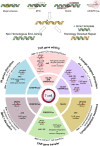TCR Redirected T Cells for Cancer Treatment: Achievements, Hurdles, and Goals
- PMID: 33013822
- PMCID: PMC7494743
- DOI: 10.3389/fimmu.2020.01689
TCR Redirected T Cells for Cancer Treatment: Achievements, Hurdles, and Goals
Abstract
Adoptive T cell therapy (ACT) is a rapidly evolving therapeutic approach designed to harness T cell specificity and function to fight diseases. Based on the evidence that T lymphocytes can mediate a potent anti-tumor response, initially ACT solely relied on the isolation, in vitro expansion, and infusion of tumor-infiltrating or circulating tumor-specific T cells. Although effective in a subset of cases, in the first ACT clinical trials several patients experienced disease progression, in some cases after temporary disease control. This evidence prompted researchers to improve ACT products by taking advantage of the continuously evolving gene engineering field and by improving manufacturing protocols, to enable the generation of effective and long-term persisting tumor-specific T cell products. Despite recent advances, several challenges, including prioritization of antigen targets, identification, and optimization of tumor-specific T cell receptors, in the development of tools enabling T cells to counteract the immunosuppressive tumor microenvironment, still need to be faced. This review aims at summarizing the major achievements, hurdles and possible solutions designed to improve the ACT efficacy and safety profile in the context of liquid and solid tumors.
Keywords: TCR - T cell receptor; adoptive T cell immunotherapy; cancer immunoediting; cancer immunotherapy; genetic engineering.
Copyright © 2020 Manfredi, Cianciotti, Potenza, Tassi, Noviello, Biondi, Ciceri, Bonini and Ruggiero.
Figures




Similar articles
-
Evolution of CD8+ T Cell Receptor (TCR) Engineered Therapies for the Treatment of Cancer.Cells. 2021 Sep 10;10(9):2379. doi: 10.3390/cells10092379. Cells. 2021. PMID: 34572028 Free PMC article. Review.
-
CAR T-cell therapy for solid tumours.Lancet Oncol. 2021 Jul;22(7):893. doi: 10.1016/S1470-2045(21)00353-3. Lancet Oncol. 2021. PMID: 34197740 No abstract available.
-
Immune Cell Hacking: Challenges and Clinical Approaches to Create Smarter Generations of Chimeric Antigen Receptor T Cells.Front Immunol. 2018 Jul 31;9:1717. doi: 10.3389/fimmu.2018.01717. eCollection 2018. Front Immunol. 2018. PMID: 30108584 Free PMC article. Review.
-
Gene Modification and Immunological Analyses for the Development of Immunotherapy Utilizing T Cells Redirected with Antigen-Specific Receptors.Methods Mol Biol. 2019;2048:27-39. doi: 10.1007/978-1-4939-9728-2_3. Methods Mol Biol. 2019. PMID: 31396926
-
Engineering Strategies to Enhance TCR-Based Adoptive T Cell Therapy.Cells. 2020 Jun 18;9(6):1485. doi: 10.3390/cells9061485. Cells. 2020. PMID: 32570906 Free PMC article. Review.
Cited by
-
TCR-engineered T cell therapy in solid tumors: State of the art and perspectives.Sci Adv. 2023 Feb 15;9(7):eadf3700. doi: 10.1126/sciadv.adf3700. Epub 2023 Feb 15. Sci Adv. 2023. PMID: 36791198 Free PMC article. Review.
-
Targeting tumor-associated macrophages in hepatocellular carcinoma: biology, strategy, and immunotherapy.Cell Death Discov. 2023 Feb 15;9(1):65. doi: 10.1038/s41420-023-01356-7. Cell Death Discov. 2023. PMID: 36792608 Free PMC article. Review.
-
A cell-based phenotypic library selection and screening approach for the de novo discovery of novel functional chimeric antigen receptors.Sci Rep. 2022 Jan 21;12(1):1136. doi: 10.1038/s41598-022-05058-5. Sci Rep. 2022. PMID: 35064152 Free PMC article.
-
Genome Editing in Engineered T Cells for Cancer Immunotherapy.Hum Gene Ther. 2023 Sep;34(17-18):853-869. doi: 10.1089/hum.2023.128. Hum Gene Ther. 2023. PMID: 37694593 Free PMC article. Review.
-
Evolution of CD8+ T Cell Receptor (TCR) Engineered Therapies for the Treatment of Cancer.Cells. 2021 Sep 10;10(9):2379. doi: 10.3390/cells10092379. Cells. 2021. PMID: 34572028 Free PMC article. Review.
References
-
- Kochenderfer JN, Wilson WH, Janik JE, Dudley ME, Stetler-Stevenson M, Feldman SA, et al. . Eradication of B-lineage cells and regression of lymphoma in a patient treated with autologous T cells genetically engineered to recognize CD19. Blood. (2010) 116:4099–102. 10.1182/blood-2010-04-281931 - DOI - PMC - PubMed
Publication types
MeSH terms
Substances
LinkOut - more resources
Full Text Sources
Other Literature Sources
Medical

